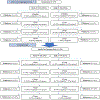Eight-Year Outcomes of Bilateral Lateral Rectus Recessions versus Unilateral Recession-Resection in Childhood Basic-Type Intermittent Exotropia
- PMID: 37696452
- PMCID: PMC10841051
- DOI: 10.1016/j.ophtha.2023.09.004
Eight-Year Outcomes of Bilateral Lateral Rectus Recessions versus Unilateral Recession-Resection in Childhood Basic-Type Intermittent Exotropia
Abstract
Purpose: To report 8-year outcomes from a randomized controlled trial (RCT) comparing bilateral lateral rectus muscle recession (BLRc) with unilateral recession-resection (R&R) for childhood intermittent exotropia (IXT).
Design: Eight-year follow-up of RCT cohort.
Participants: Of 197 randomized participants, 123 agreed to continue follow-up after the 3-year outcome visit (baseline age, 3-< 11 years; basic-type IXT, 15-40 prism diopters [Δ] by prism and alternate cover test [PACT]; baseline stereoacuity, ≤ 400 arcsec; no prior surgery).
Methods: After the RCT primary outcome at 3 years, annual follow-up from 4 through 8 years with treatment at investigator discretion.
Main outcome measures: Suboptimal surgical outcome by 8 years after randomization, defined as any of the following at any visit: exotropia of 10 Δ or more by simultaneous prism cover test (SPCT) at distance or near, constant esotropia (ET) of 6 Δ or more by SPCT at distance or near, loss of near stereoacuity by 0.6 log arcsec or more from baseline, or reoperation. Secondary outcomes included (1) reoperation by 8 years and (2) complete or near-complete resolution at 8 years, defined as exodeviation of less than 10 Δ by SPCT and PACT at distance and near and 10 Δ or more reduction from baseline by PACT at distance and near, ET of less than 6 Δ at distance and near, no decrease in stereoacuity by 0.6 log arcsec or more from baseline, and no reoperation or nonsurgical treatment for IXT.
Results: The Kaplan-Meier cumulative probability of suboptimal surgical outcome through 8 years was 68% (55 events among 101 at risk) for BLRc and 53% (42 events among 96 at risk) for R&R (difference, 15%; 95% confidence interval [CI], -2% to 32%; P = 0.08). Complete or near-complete resolution at 8 years occurred in 15% (7/46) for BLRc and 37% (16/43) for R&R (difference, -22%; 95% CI, -44% to -0.1%; P = 0.049). The cumulative probability of reoperation was 30% for BLRc and 11% for R&R (difference, 19%; 95% CI, 2%-36%; P = 0.049).
Conclusions: Despite no significant difference for the primary outcome, the 95% CI did not exclude a moderate benefit of R&R, which together with secondary outcomes suggests that unilateral R&R followed by usual care may yield better long-term outcomes than BLRc followed by usual care for basic-type childhood IXT using these surgical doses.
Financial disclosure(s): Proprietary or commercial disclosure may be found in the Footnotes and Disclosures at the end of this article.
Keywords: Intermittent exotropia; Pediatric ophthalmology; Strabismus.
Copyright © 2023 American Academy of Ophthalmology. Published by Elsevier Inc. All rights reserved.
Conflict of interest statement
Figures



References
-
- Govindan M, Mohney BG, Diehl NN, Burke JP. Incidence and types of childhood exotropia: A population-based study. Ophthalmology. Jan 2005;112(1):104–108. - PubMed
-
- Von Noorden GK, Campos EC. Exodeviations. In: Lampert R, Cox K, Burke D, eds. Binocular Vision and Ocular Motility: Theory and Management of Strabismus. 6th ed. Mosby; 2002:356–376.
-
- Wright KW. Exotropia. In: Wright KW, ed. Pediatric Ophthalmology and Strabismus. Mosby-Year Book, Inc.; 1995:195–202.
-
- Mitchell PR, Parks MM. Concomitant Exodeviations. In: Tasman WS, ed. Duane's Clinical Ophthalmology. Lippincott Williams & Wilkins; 2000:1–17:chap 13.
Publication types
MeSH terms
Grants and funding
LinkOut - more resources
Full Text Sources
Medical
Miscellaneous

